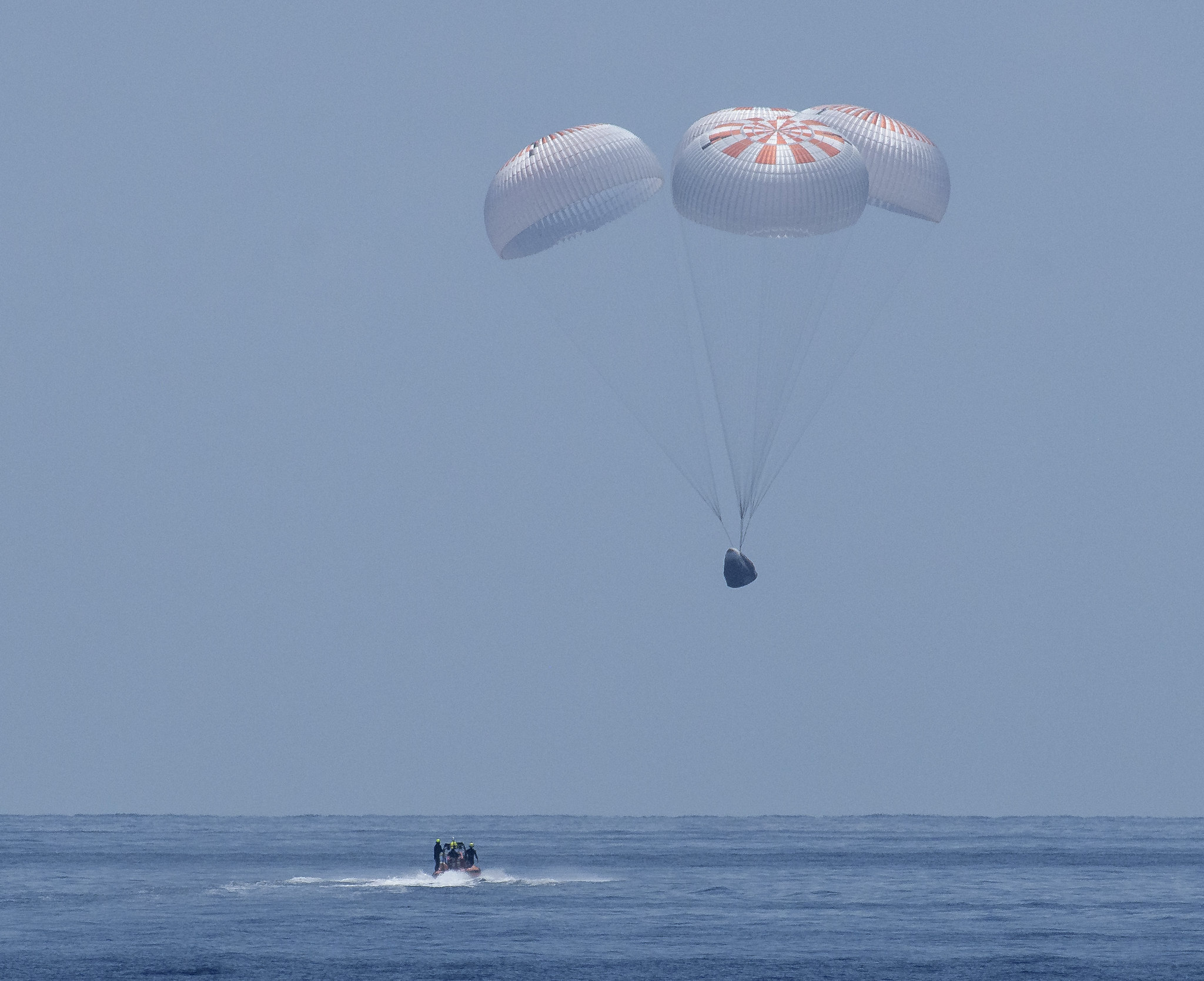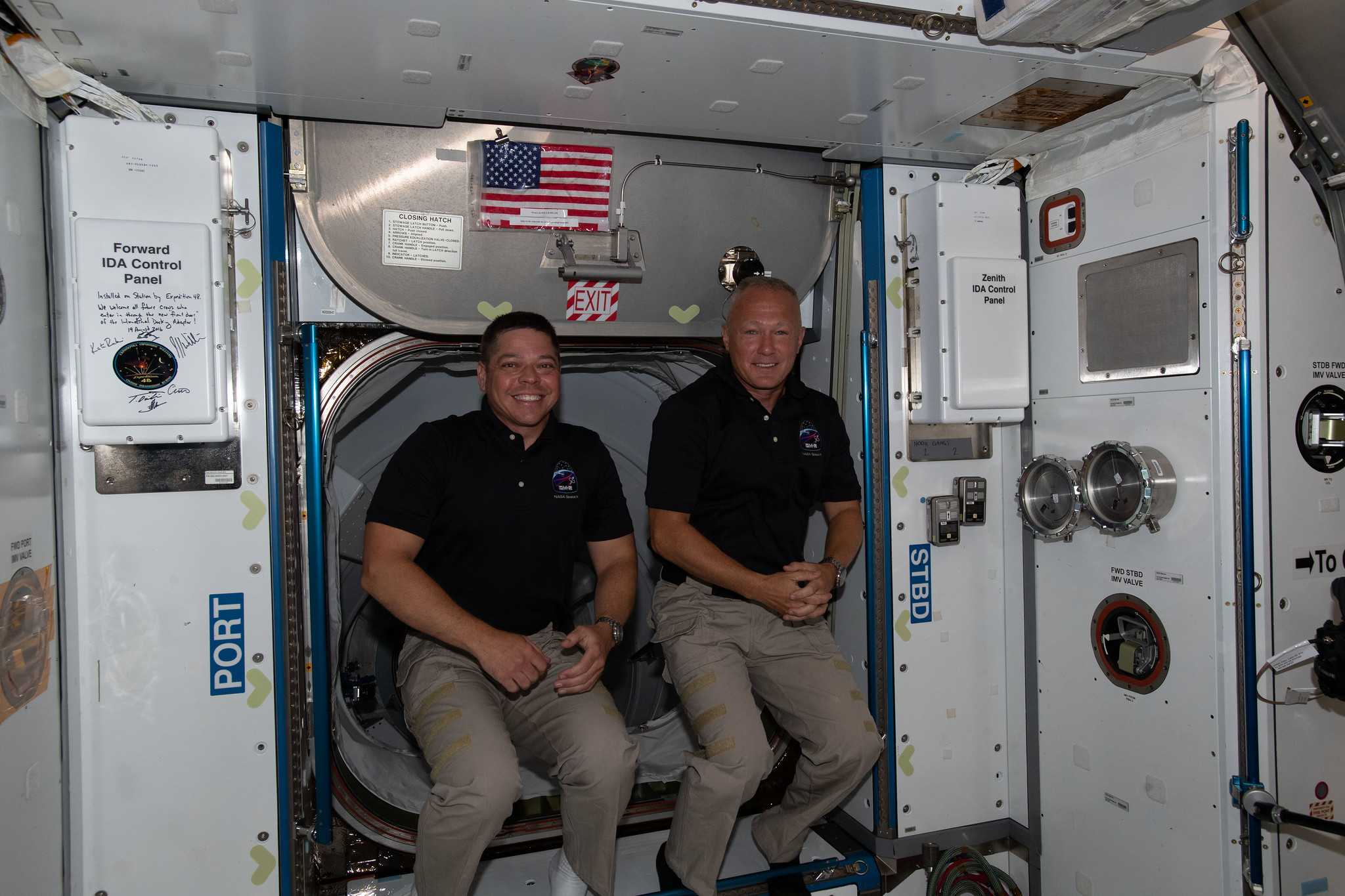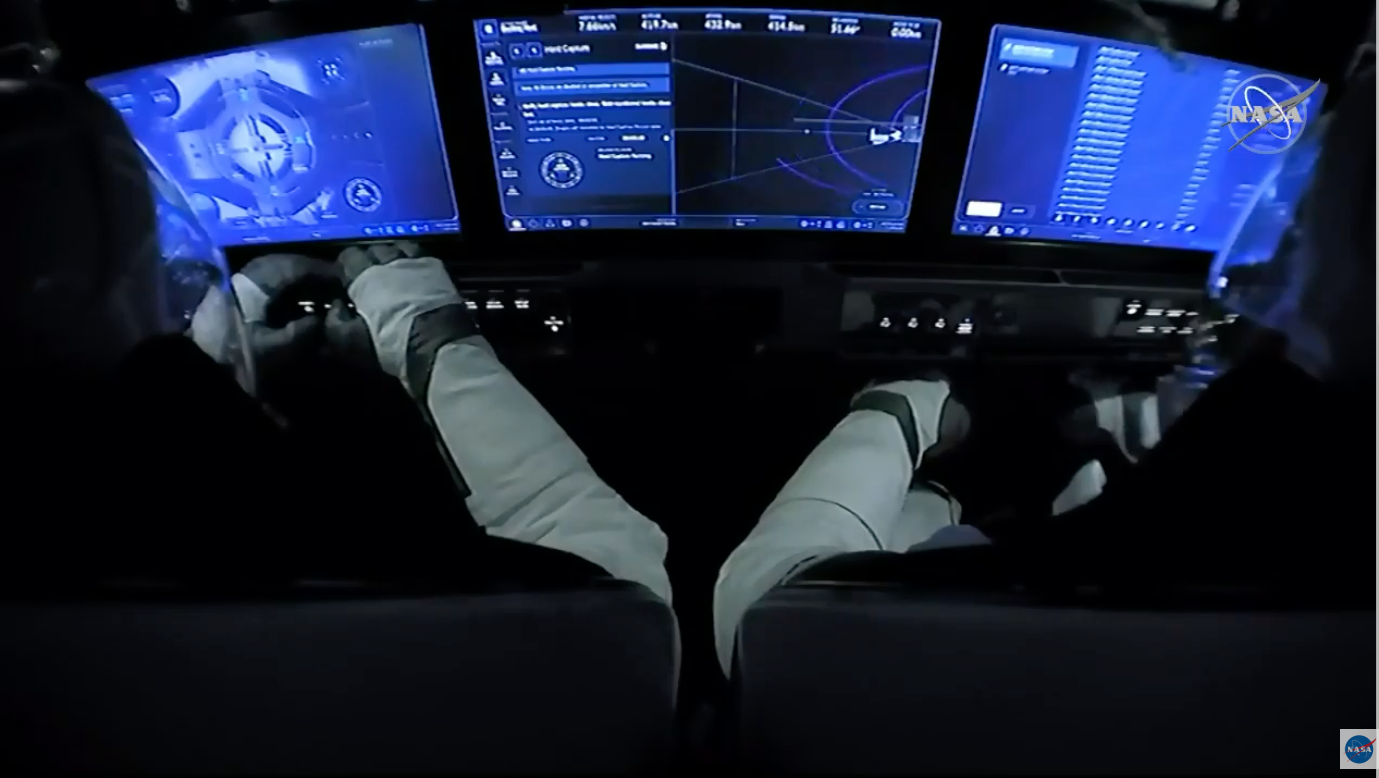
Yesterday’s successful return of Dragon Endeavour crewmen Doug Hurley and Bob Behnken after almost 64 days in space—of which 62 were spent aboard the International Space Station (ISS)—and 1,024 orbits draws down the curtain on the first mission of the Commercial Crew era. For the first time in history, humans have launched aboard a commercially-developed spacecraft and atop a commercially-provided rocket, and “Bob and Doug’s Excellent Adventure” closed out Sunday afternoon with the first oceanic splashdown of a U.S. crew since the Apollo-Soyuz Test Project (ASTP) in July 1975. Their return to Earth comes only days after the Falcon 9 booster for the Crew-1 mission arrived in Florida for processing and a multi-national team of four astronauts from the United States, Japan and France were assigned to the Crew-2 flight, slated to launch early next spring.

And it has been not only a spectacular 64 days, but a remarkable two decades for Hurley and Behnken. Both men were selected together as NASA astronaut candidates back in July 2000, members of the “Bugs” class, and both went on to marry fellow members of their class.

Behnken served as a Mission Specialist on two shuttle flights. STS-123 in March 2008 delivered the first pressurized component of Japan’s Kibo (“Hope”) lab and Canada’s Dextre Special Purpose Dextrous Manipulator (SPDM) “hand”, whilst STS-130 in February 2010 installed and opened for business the Tranquility Node-3 module and the multi-windowed cupola. In doing so, he logged over 29 days in space and six sessions of Extravehicular Activity (EVA). Both of Behnken’s missions were on shuttle Endeavour.

Hurley, meanwhile, also flew his first shuttle mission on Endeavour, a commonality which prompted them both to name their Dragon ship “Endeavour” in its honor, shortly after achieving orbit on 30 May. Hurley’s first flight was as Pilot on STS-127 in July 2009, which delivered the final external components of the Kibo lab, and he also served in the same role aboard Atlantis for STS-135 in July 2011 for the final voyage of the Space Shuttle Program. Hurley logged more than 28 days in space on those flights.

Following their shuttle careers, both men followed somewhat different paths. Behnken served as deputy chief of the astronaut corps, then did a three-year tenure as chief from 2012-2015. Meanwhile, Hurley served as assistant director of new programs within the Flight Crew Operations Directorate (FCOD) and from 2014 was assistant director of the Commercial Crew Program. Both men’s experience and expertise prepared them amply for their assignment in June 2015—alongside former astronaut office deputy chiefs Suni Williams and Eric Boe—to the first “cadre” of Commercial Crew flyers. After much cross-training on both Boeing’s CST-100 Starliner and SpaceX’s Crew Dragon, in August 2018 Hurley and Behnken were assigned to Demo-2.

Originally scheduled to begin regular operational flights to the ISS in 2017, the Commercial Crew Program fell victim to years of delay caused by technical issues and Congressional underfunding, which certainly earned the ire of then-NASA Administrator Charlie Bolden. And as the delays lengthened, and it became abundantly clear that the first crewed mission would not occur until 2020, NASA and SpaceX decided to extend Demo-2 from its original guise as a one-to-two-week test flight to the ISS to a longer “expedition” of up to four months.

This decision was inadvertently aided by last year’s loss of the Demo-1 craft during a ground test. Flown in an uncrewed capacity to the ISS in March 2019, the Demo-1 vehicle was targeted to be used again on the In-Flight Abort test. Its destruction meant that the test, which finally took place last January, had to use the next Crew Dragon off the production line: the one originally earmarked for Hurley and Behnken. Correspondingly, they picked up the next ship in line, originally slated for the first operational Crew Dragon mission: a vehicle capable of supporting them for a more lengthy stay in orbit.

Another facet in the decision to extend Hurley and Behnken’s mission was a realization that only a single U.S. astronaut—Expedition 63 Commander Chris Cassidy, launched last April—would be aboard the ISS for most of 2020. The resultant implications in terms of limited “extra hands” to support science and maintenance made the need for Commercial Crew to hit the ground running still more acute.
As such, Behnken and Hurley’s already-heavy training regime was extended to include not only science training, but also preparations for several spacewalks. At length, in April, NASA and SpaceX formally announced that Demo-2 would launch on 27 May and, dependent upon the performance of its power-producing solar arrays and other systems, would remain in orbit until August or even as late as mid-September.

Following a three-day delay, caused by poor weather conditions on the Space Coast, Hurley and Behnken launched smoothly from historic Pad 39A at the Kennedy Space Center (KSC) in Florida at 3:22 p.m. EDT on 30 May. In interviews conducted later in orbit, they offered a few words of description after becoming the first humans to fly SpaceX’s two-stage Falcon 9 booster and the similarities and differences from their earlier experience aboard the shuttle.
Behnken noted that he was “surprised a little bit at how smooth things were off the pad”, which lulled him into a false sense that the remainder of the ride would prove equally smooth. But falcons and dragons are notoriously fearsome creatures. “Dragon was huffing and puffing all the way into orbit,” he said, “and we were definitely driving and riding a dragon the whole way.” He and Hurley have two previous shuttle missions each to their credit—the ascent profile of which was characterized by the harsh staccato crackle of the twin Solid Rocket Boosters (SRBs), juxtaposed against the smoother, more “electric” feel of the three Space Shuttle Main Engines (SSMEs)—and Behnken noted that the Falcon 9 displayed “a little bit less G’s, but a little bit more alive!”

Less than 19 hours after launch, at 10:16 a.m. EDT on 31 May, Dragon Endeavour docked smoothly at the International Docking Adapter (IDA)-2 “end” of the Harmony node. It was the quickest uphill ride of a U.S. crewed vehicle to reach a space station since the eight-hour rendezvous transits of the Skylab era in the early 1970s.

During the journey, Crew Dragon autonomously executed a series of phasing burns to accomplish a picture-perfect approach and rendezvous, although Hurley took manual control at two key points in a pre-planned exercise to evaluate his ship’s capabilities. Docking occurred several minutes ahead of the timeline and, having conducted requisite pressurization and leak checks, the hatches were opened and Hurley and Behnken came aboard to be greeted with hugs from Expedition 63 Commander Chris Cassidy and his Russian crewmates Anatoli Ivanishin and Ivan Vagner.
It was anticipated before launch that Cassidy and Behnken would perform a series of spacewalks to remove 12 aging nickel-hydrogen batteries from the station’s S-6 truss and replace them with six smaller and more capable lithium-ion batteries to accommodate ISS power needs through the remainder of its operational lifetime. As circumstances transpired, the two men—assisted by Hurley and Vagner with suiting-up in the station’s Quest airlock and also by Hurley with Canadarm2 operations—went on to perform four sessions of EVA, totaling 23 hours and 37 minutes.
During their first EVA on 26 June and their second EVA on 1 July, Cassidy and Behnken removed six nickel-hydrogen batteries from Channel 1B (one of the two S-6 power channels) and fitted three lithium-ion units, as well as enjoying a spot of banter with Capcom Jasmin Moghbeli, who delivered them a seemingly never-ending list of safety cautions.

Another pair of EVAs were then performed on 16 July and 21 July, during which they removed six more nickel-hydrogen batteries from Channel 3B and replaced them with three lithium-ion ones. The spacewalkers also tended to a number of get-ahead tasks, removing H-fixtures from the base of the solar arrays, installing the Robotic Tool Stowage (RiTS) onto the Mobile Base System (MBS) and preparing the port-side Common Berthing Mechanism (CBM) of the Tranquility node for its role in supporting NanoRacks’ Bishop commercial airlock when it comes uphill aboard a SpaceX Dragon later this year.

With both Cassidy and Behnken having already logged six EVAs earlier in their careers, the four they added their respective tallies in the last few weeks have made them two of only four Americans to have logged as many as ten spacewalks. Notably, Behnken now sits as the fourth most experienced spacewalker in history, with 61 hours and 10 minutes of EVA time.
Of course, spacewalking was but the most visible aspect of Hurley and Behnken’s Demo-2 stay on the ISS. They were also involved closely in a series of tests of Dragon Endeavour as it enjoyed a virtually trouble-free eight-week stay at the sprawling multi-national orbital outpost. The astronauts visited the spacecraft every few days to check its functionality and on 8 July, with Cassidy and Ivanishin joining them, Hurley and Behnken participated in an hour-long “habitability” study to ascertain how the craft will cater for full crews of four. They verified Dragon Endeavour’s features and functionality, opened and closed its hatch, operated its waste system and moved cargo back into the vehicle.

The Dragon Endeavour crewmen have also taken on the roles of scientists, plumbers, engineers and—in Hurley’s case—also crew medical officer, responsible for checking up on his comrades and performing retinal scans. Hurley worked extensively with the AstroBee free-flying robotic assistance and also supported computer maintenance, whilst Behnken and Cassidy also conducted a periodic inspection of the Bigelow Expandable Activity Module (BEAM) to check its sensor batteries and replace charcoal filters. All told, Hurley and Behnken completed more than 100 hours of science during their time aboard the ISS.

During their training, they actively participated in an emergency drill, honing essential skills such as cardiopulmonary resuscitation (CPR) techniques, efficiently locating medical equipment, and coordinating with ground controllers. For more information on CPR certifications, read more here. Additionally, their research endeavors encompassed the deployment of CubeSats, operations involving the furnaces of the Materials Science Laboratory (MSL), and configuring the Hyperspectral Imaging Suite (HISUI) on the exterior of Japan’s Kibo lab.

Hurley also demonstrated his competence as an accomplished photographer, returning some stunning perspectives of landmarks on Earth. This seemingly unknown talent was jokingly referenced by his wife, former astronaut and seasoned ISS resident Karen Nyberg, who expressed surprise as to why she was always required to take the holiday snaps on Earth. As for Behnken, he turned 50 years old on 28 July, joining the entire crew—with the exception of 35-year-old Vagner—in the “Over 50s Club”.

In mid-July, it was finally announced that Dragon Endeavour would undock on 1 August and return to Earth the next day. And in recent days, as their two months in orbit began to wind down, Hurley and Behnken began packing and stowing their personal gear, trying on their SpaceX launch and entry suits and readying their ship for departure. They also pulled out all the stops on their jogging and workout sessions to prepare their bodies for the punishing onset of terrestrial gravity.

With Sunday’s picture-perfect splashdown in the Atlantic Ocean, Demo-1 and the completion of “Bob and Doug’s Excellent Adventure” has laid the cornerstone for missions to come. With four crew members slated to fly future Crew Dragon missions—and with three others due to fly twice per year aboard Russia’s Soyuz—it is expected that the ISS population will correspondingly expand from a previously-standard six people to seven. That is expected to be augmented by Boeing’s CST-100 Starliner, due to begin ferrying astronauts to the ISS next year. And the increased number of crew aboard the station should virtually double the amount of crew time available for science.

Next up are Crew-1, no earlier than the end of September, with NASA astronauts Mike Hopkins, Victor Glover and Shannon Walker, together with Soichi Noguchi of the Japan Aerospace Exploration Agency (JAXA), who will spend between five and six months aboard the station. The first-stage core of their Falcon 9 booster arrived at KSC from SpaceX’s test site in McGregor, Texas, on 17 July. More recently, on Bob Behnken’s birthday, his wife—fellow astronaut Megan McArthur—was assigned, alongside NASA veteran Shane Kimbrough and crewmates Akihiko Hoshide of JAXA and Thomas Pesquet of the European Space Agency (ESA), to Crew-2, who will fly another Crew Dragon uphill in the spring of 2021.






Congratulations on a job well done!
Looking forward to hi-def pictures of the lunar surface, hopefully in the not-too distant future.